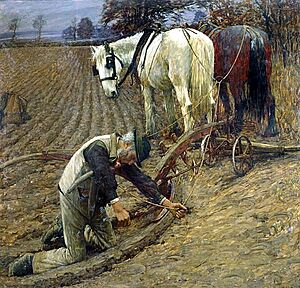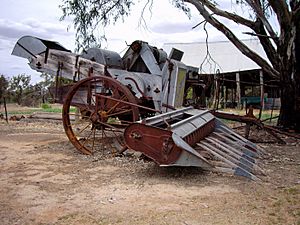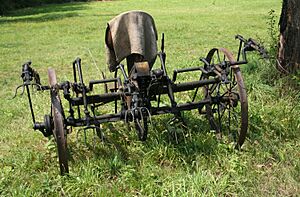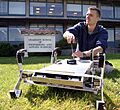Agricultural engineering facts for kids
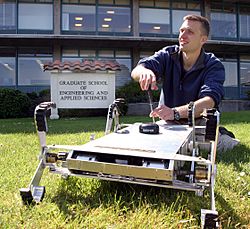
An agricultural and biosystems engineer fixing an agricultural robot
|
|
| Occupation | |
|---|---|
| Names | Agricultural engineer, agricultural and biosystems engineer |
|
Occupation type
|
Profession |
|
Activity sectors
|
Engineering, agriculture |
| Description | |
| Competencies | Engineering, agriculture |
|
Fields of
employment |
Engineering, agribusiness, farm |
|
Related jobs
|
Agriculturist, farmer, farm worker, engineer |
Agricultural engineering, also called agricultural and biosystems engineering, is a cool field that mixes engineering with agriculture. It's all about using science and design to make farming better and more efficient. This job brings together different types of engineering, like mechanical, civil, electrical, and chemical engineering. It also includes food science, environmental studies, and even software skills.
The main goal is to help farms and big farming businesses work smarter. Agricultural engineers also make sure we use our natural resources, like water and soil, in a way that protects them for the future. An agricultural engineer is an engineer who knows a lot about farming. They create engineering designs and plans for farm projects. Often, they work with an agriculturist, who is an expert in farming and agricultural science.
Contents
How Agricultural Engineering Started

People started using agricultural engineering a very long time ago. One of the first big steps was using irrigation to water crops on a large scale. This happened in places like the Nile and Euphrates river valleys over 4,000 years ago. Ancient civilizations in Baluchistan and India also built large irrigation systems. In South America, the Incas in Peru and the Aztecs in North America used irrigation too.
Early farmers used simple tools like the ard, which was a basic scratch-plough. Later, settlers in places like San Antonio (in 1715) and the Mormons in Salt Lake Valley (in 1847) also used irrigation.
As the industrial revolution began, machines and steam power changed everything. This started a new era for agricultural engineering. Over time, machines like mechanical harvesters and planters began to do the work that many farmhands used to do.
- In 1761, John Lloyd, Magnus Strindberg, and Dietrich introduced machines for threshing (separating grain from stalks).
- Andrew Meikle built a better threshing machine in 1786.
- Charles Newbold made the first cast iron plow between 1790 and 1796.
- James Smith built a mower in 1811.
- John Deere made his first steel plow in 1833, which was a big improvement.
- In 1886, George Stockton Berry used a steam-powered combine harvester.
- Around 1861, the two-horse cultivator became popular.
These new machines and ideas led to a huge increase in how much food farms could produce. This period is sometimes called a "second agricultural revolution". It involved:
- Farmers starting to grow crops to sell, not just to feed their families.
- New ways of growing crops and raising animals.
- Machines doing more of the work instead of people.
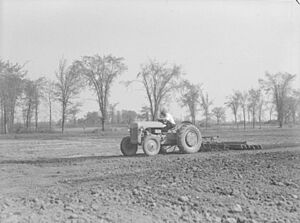
In the 1900s, with better airplane engines, cropdusters started flying over fields to spray pesticides.
- Benjamin Holt built a combine harvester that ran on petrol in 1911.
- Erwin Peucker created the bulldog tractor in 1936.
- Deutz-Fahr made the rotary hay tedder in 1961.
Towards the end of the 20th century, genetically modified foods (GMOs) were developed. These foods also helped farms grow more crops and made them stronger against pests.
What Agricultural Engineers Do
Agricultural engineers do many important jobs. They might:
- Plan and manage projects for things like dairy farm waste systems.
- Design irrigation systems to water crops or drainage systems to remove excess water.
- Work on systems to control flood water.
- Figure out how farming affects the environment (called environmental impact assessments).
- Help with processing agricultural products.
- Understand research results and put new farming ideas into practice.
Many agricultural engineers work at universities or for government groups. Some work as consultants for private engineering companies. Others work for companies that make farm machines, equipment, or buildings for animals and crops. Agricultural engineers can work in making products, sales, management, research, or applied science.
Agricultural Engineering Around the World
Agricultural engineering is important in many countries. For example, in the Philippines, people who work in this field are called registered agricultural and biosystems engineers. They need to pass an exam and have a four-year Bachelor of Science degree in Agricultural and Biosystems Engineering.
In the Philippines, agricultural engineers can:
- Give advice and manage services related to agricultural engineering.
- Manage and create designs for farm machines, buildings, and energy systems.
- Work on systems for irrigation, soil care, and waste use.
- Do research, training, and consulting on farm engineering.
- Test and check farm machinery and equipment.
- Work in manufacturing or selling farm machines.
- Teach agricultural engineering subjects.
- Work for the government in jobs that need their special skills.
In the United Kingdom, the term "agricultural engineer" often means someone who fixes or changes farm equipment.
In the United States, the American Society of Agricultural and Biological Engineers (ASABE) was started in 1907. It's a big group in this field. The ASABE creates safety rules and standards for the farming industry. These rules are used all over the world for things like fertilizers, soil, fishing, biofuels, tractors, and other farm machines.
Sub-Disciplines
Agricultural engineering has many different areas of focus. Here are some of the most common ones:
Agricultural Machinery
This area focuses on designing and improving machines used in farming, like tractors and harvesters.
Agricultural Structures
This involves designing and building structures for farms, such as barns, silos, and greenhouses.
Agricultural Surveying
This is about measuring and mapping land for farming purposes.
Aquaculture
This field deals with farming aquatic animals and plants, like fish and seaweed.
Biomechanics & Ergonomics
This looks at how people interact with farm equipment and how to make it safer and more comfortable to use.
Forestry Engineering
This branch applies engineering principles to managing and using forests.
Irrigation
This focuses on systems for watering crops efficiently.
Land Development
This involves planning and changing land for farming or other agricultural uses.
Pesticides
This area studies how to use pesticides safely and effectively to protect crops.
Precision Agriculture
This uses technology like GPS and sensors to manage farms very precisely, saving resources.
Soil Management
This is about keeping soil healthy and productive for growing crops.
Images for kids
See Also
 In Spanish: Ingeniería agrícola para niños
In Spanish: Ingeniería agrícola para niños

- Agricultural education
- Agricultural science
- Agronomy
- Bioresource engineering
- Biosystems engineering
- Copper alloys in aquaculture
- Industrial agriculture
- Institution of Agricultural Engineers
- List of agricultural machinery
- Mechanized agriculture
- Water softening


